How to Test for Varroa Mites
To ensure healthy honey bee colonies, early detection of varroa mite infestations is vital. There are several popular methods used to test for varroa mites in beehives. These mite checks give an estimation of the problem. None are perfect but they are an important tool in the struggle.
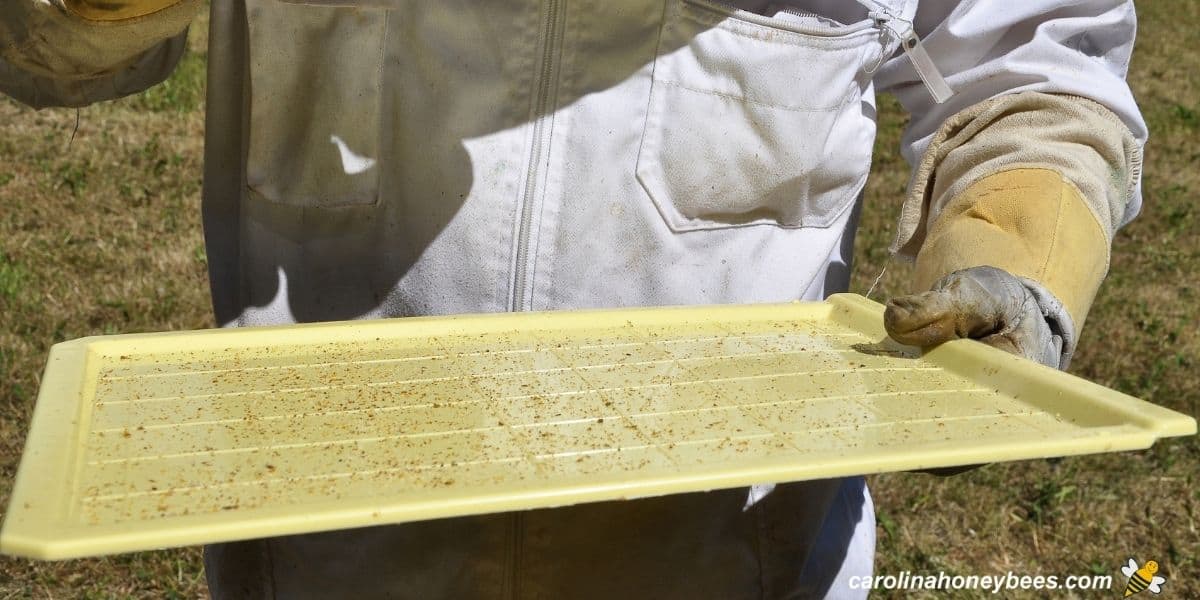
Many (or most) honey bee colonies have some varroa mites in residence. It is the level of infestation that beekeepers must monitor to keep healthy bees. Rather than eradication, this major pest of honey bees must be controlled.
Varroa Mites and Testing Frequency
Varroa mites (Varroa destructor) are parasitic arachnids that feed on adult honey bees, this weakens the colony. Worker bees are sickly and less productive and the bees do not live as long.
Even worse, they also feed on developing bee brood – resulting in deformed sick bees. Varroa are also vectors for many viruses and diseases.
They can carry and spread these pathogens to other members of the hive. Keeping mite numbers low is essential to avoid total colony collapse.
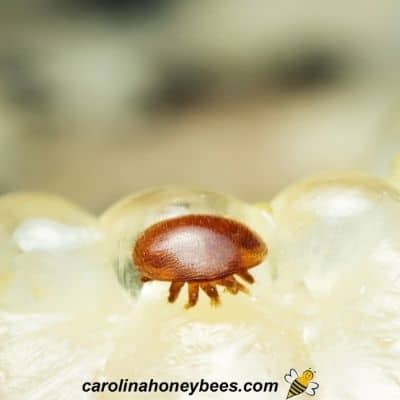
Basic Mite Testing Schedule
Unfortunately, testing for varroa mites is not a one and done procedure. If you live in a region with mites (and most folks do), monitoring mite levels is a season long activity.
Times when brood is present in the hive represent the highest risk. The only way to know an approximation of varroa mite numbers in the hive is to test.
Determining when to treat your bees for mites involves many factors beyond just a date on the calendar. But, we do have a bare minimum schedule.
- very early Spring
- early Summer (Late May-June)
- Late Summer (August)
- Late Fall (October)
Another general guideline is to check for varroa mites once a month during the warm season. And no, you can not rely on visual inspections by the time you see mites on bees – it may be too late to do anything.
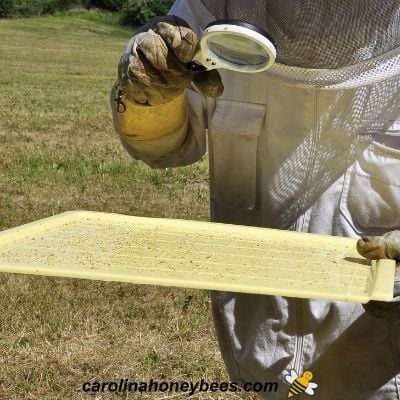
This post may contain affiliate links. As an Amazon Associate, I earn from qualifying purchases. Please read my disclosure.
Popular Testing Methods
The level of mite infestation can be determined by several methods. Each method has benefits, as well as, drawbacks and limitations. Try several until you find the one that fits your style best.
- alcohol wash – soapy water
- sugar shake
- sticky board drop
Alcohol Wash Method (or Soapy Water)
Take 300 bees from the brood frame area of the hive. Just shake the nurse bees off the frame into a box or collection container (don’t get the queen !!!). This is about ½ cup of bees.
Pour bees into a wide mouth glass jar with a small mesh wire for a lid. You can make your own jar or purchase one ready to use. Add soapy water (or 70% isopropyl alcohol) and shake gently for a minute.
Pour out the liquid through the mesh wire to strain out the bees – into another container. Then re-pour liquid through a smaller mesh filer (coffee filter, cotton cloth etc).
Count the mites on the filter material. (A similar method uses Ether in the same manner). Of course this kills the bees you are using!!!
*It is better to sacrifice 300 bees than to allow thousands to die due to varroa infestation. (But, I just cannot do this. ☹ Beekeeper Charlotte) I know – it is one of my beekeeper failings.
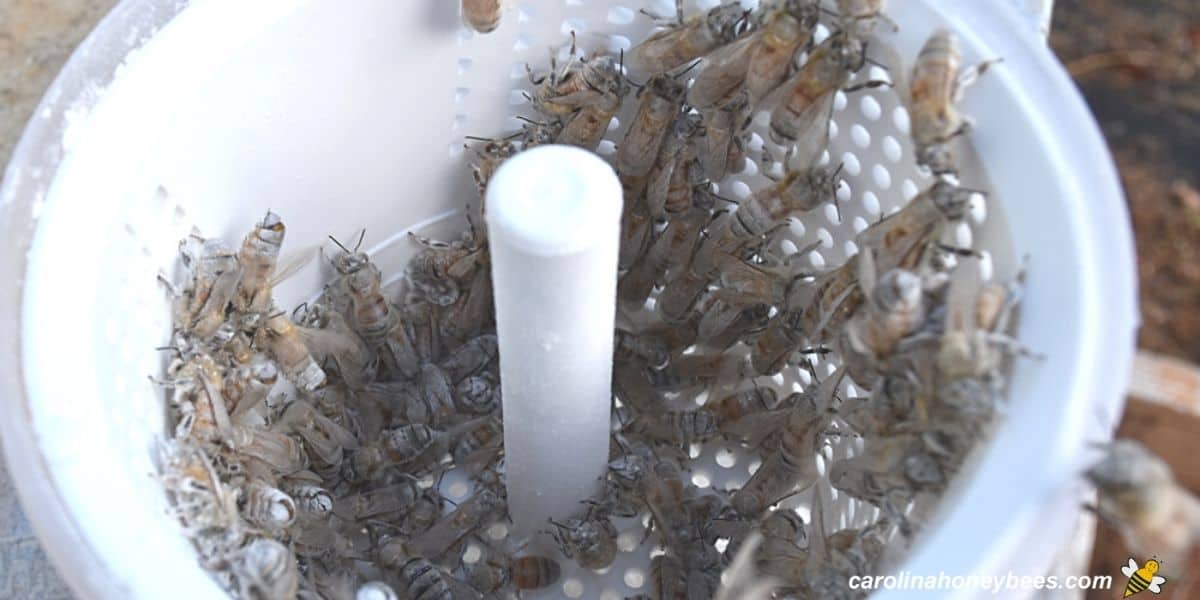
Powdered Sugar Shake Method
Harvest 300 bees as above – don’t get the queen! Pour bees into wide mouth glass jar fitted with a mesh lid. (#8 mesh hardware cloth). Or you can purchase a testing unit from Mann Lake (that’s what I use).
Simply brush the bees off the frame into the cup basket until you get the needed amount. Then, add 1 – 3 Tablespoons of powdered sugar to the container, put on lid and gently shake.
If you need to, set the jar in the sun for a minute (very briefly) to increase humidity. Gently shake the sugar out of the jar (thru the mesh lid) onto a white surface and count the mites.
Release the sugar-coated bees. (Warning – they will be alive but they may not be happy!)

Determine the Varroa Mite Count
In both of these methods, we are dislodging mites from adult bees and counting them. How many varroa mites is too many? To determine infestation percentage: Divide the number of mites by the number of bees.
If you find 12 mites: 12 divided by 300 = 4% infestation. Most resources consider numbers over 3% to be a high mite level. I am unhappy with anything over 2%.
If your infestation level is below 2%, you may decide to test again in a month or go ahead and treat – it is your call.
Sticky Board or Screened Bottom Boards
Every day mites and bees share the space inside the beehive. In the normal hustle and bustle, some mites will fall. Researchers have determined a guideline for detecting the level of infestation by the number that fall to the bottom.
Screened bottom boards normally come with a white grid board that can be inserted for performing mite checks. Don’t leave that board in all the time – it cuts down on important hive ventilation.
Perform a Natural Drop Count
Apply a thin coating of Vaseline or cooking spray to one side of the white board. You can also buy liners that are already sticky if you wish.
The greased sticky board is placed under the screen bottom for 24 hours and then removed. The screen prevents bees from getting stuck on the board.
If you have solid wood bottom boards, you can purchase a special screen insert to allow counting. Inspect your sticky board and look for mites. How many do you see?

The numbers seem to change from year to year. But, most experts recommend that more than 30 mites dropped in a 24-hour period is too many. However, this is a highly contested number because there are so many variables.
While the ideal situation would be to have colonies with zero mites, that is not usually possible. Most colonies do have some mites and they do deal with the situation well.

Drone Brood Inspections
The life cycle of Varroa Mites and the honey bee life cycle weighs heavily in favor of the mites. They can identify whether a bee larva is worker or drone. They will use both but drone brood is preferred.
The female mite has time to produce 1 mature daughter (maybe 2) in a worker cell. However, if she inhabits a drone cell (with a longer time capped in the cell) she can produce 2 to 3 daughters.
When performing beehive inspections, you may discover drone brood in the stray comb between the boxes. In this case, always check quickly for mites.
Of course, not seeing mites in your exposed drone brood is no guarantee that your colony is safe. But, it is always a good idea to check for varroa mites.
You can also use your hive tool (or better) uncapping fork to destroy a small section of developing drones and check for mites inside.
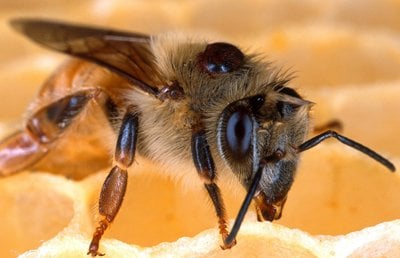
Why Visual Testing Doesn’t Work
Because these are external pests that can be seen with the naked eye, you might think you can just look, right? Can you check your bees for mites by looking? Well, yes you can but its not easy or reliable.
There is no way you can get a true visual assessment of varroa mite numbers. This is because at any given time the vast majority of mites are inside capped brood cells.
By the time you see adult mites on the bees, it could be too late for the colony to rebound from the infestation.
Once enough bees are sick and enough disease is spread, the colony reaches a point of no return. This is why we use various methods of checking mite levels regularly.
Common Challenges in Varroa Mite Testing
In a hive with thousands of insects, counting anything is really just as estimate. There are a few inherit challenges in testing your colonies for mites.
- sample size and bias
- timing and development stages
- beekeeper skill and consistency
- some tests kill bees or disturb the hive
- environmental factors
Sample Size & Bias
When using either of the shake tests for varroa, it is important to get bees from the brood nest area of the hive. Mites hope to get into those brood cells to reproduce. The bees in that area of the hive tend to have the higher number of mites. Adult foragers collected from the top of the hive may not be a true sample.
Timing & Development Stages
In the same way that the number of bees in the hive fluctuates during the season – so does the number of mites. At times when brood rearing is at its peak, there will be more mites under those wax caps – but not necessarily as many on the adult bees.
Beekeeper Skill & Consistency
To get consistent results, we must perform the test in the same way each time. But, sometimes it is difficult to measure out 1/2 cup of live bees and get them in the jar. Also, being sure to not get the queen bee while gathering adults from the brood nest!
Disturbing the Hive
Even though honey bees are usually very understanding about our intrusions, any activity we do stresses the hive. And, some of the methods for testing for varroa result in 300 or more dead bees. A necessary loss but still a loss.
Environmental Factors
Environmental factors can make testing more difficult. During late Summer when the hives are strong and the weather is hot – colonies may be more aggressive. They do not appreciate any disturbance.
Also, for those who choose to do the sugar shake method of testing. Powdered sugar clumps a lot if the humidity is high. It is not always easy being a beekeeper.
FAQs
Testing bee colonies for varroa mites is important because it allows the beekeeper to monitor the level of infestation. If the number of mites in the hive becomes too high – the colony will die.
Testing frequency depends on factors like geographical location, climate, and beekeeping practices. At least monthly and always test a couple of weeks after a mite treatment to make sure it worked.
Both the natural bottom board drop and the sugar shake method are less invasive and do not harm bees. However, the numbers are not as accurate as other methods.
Temperature, humidity, and seasonal variations can influence mite behavior and distribution within the hive.
Yes, it is a common myth that new hives will not suffer high mite levels the first year. Do a mite count.
Final Thoughts
If growing varroa levels let you know it is time to do something, it is time to consider your options. There are many varroa mite treatments to try – find one that works for you. Do not let anyone convince you that your new colonies have no mite worries.
Sometimes, mite infestations do not kill a colony until the second year. It takes that long for a strong colony to become so weak and diseased that it will fail.

